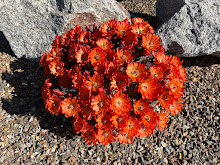This was the first of two bee houses David made to order last year. The first and smaller one, I completed and wrote about last fall. I cut and filled the A frame with the cardboard tubes from trouser coat hangers ( the easy bit). They worked well and the apartments were quickly filled.
Here is the original one today. Insects have left their nest, as shown by the holes in the mud sealed entrance, and I really should do a fall clean-up of the empty ones. This time I shall replace them with bamboo.
The second, larger one, lay on the bench in the garage until a couple of weeks ago. When ESP was cutting down some of his bamboo I asked him if he had any to spare, and he did. I was amazed at how thick his bamboo was but nevertheless I cut several pieces to go along with some thinner bamboo I already had, ( that bit took me ages) and I packed the pieces in. Of course the subsequent dry weather loosened the pieces so I had to add some more to tighten the whole structure.
The bamboo certainly looks a lot nicer. This bee house is for our grandson, who turns 6 in November, so I decided to dress it up a little.
I shingled the roof using pieces of bark I found around the wood pile. Then used a couple of strips of cedar bark to dress up the front. ( Hope the golden cheek warbler's don't mind)
Providing a home for pollinating insects is very important to the health of the garden in general. These holes are used by the solitary bees and wasps, insects that feed upon pollen and in so doing pollinate our plants. Sometimes they use mud to fill in the hole and other times leaf cuttings. If you find plants in your garden with round holes cut out of the leaves then you can be sure that you have leaf cutter bees ( Megachile species). They seem to favor beautyberry and roses in my garden.
I have a much larger critter house in the planning stage, (English gardens are full of ideas for such projects). It has been on my 'to do' list for a while and today we picked up a piece of wood at a garage sale perfect for the project. It will serve as a winter home for more than bees. Maybe lizards and hedgehogs. Oh! I forgot no hedgehogs in Texas unless you want to pay $100!
Saturday, October 22, 2011
Subscribe to:
Post Comments (Atom)































9 comments:
These are beautiful houses! I love the idea of making your own. The bamboo idea is terrific. I have the circle cuts in my bauhinia leaves and native redbud, but I never see the bees. Do you ever see them? I'd love to know what they look like.
David/ :-)
Love, love, love them! Clever and just perfect for our native bee populations! Thank you for sharing. gail
Beautiful! I love the combination of materials. We had bees nesting in our bee boxes this year -- it's an interesting experiment to figure out which ones are most appealing. So far, cedar in the shade is winning over bamboo in the sun. But it might have something to do with the different diameters of the bamboo. On the other hand, the bamboo house has sheltered other critters, so it's all good.
Those look wonderful. I'm inspired.
Great idea for Xmas presents.
David- I have never seen the bees either and they are very secretive about going into the holes. Last just I never expected them to use the tubes as it was late when I put it up. They did.
Gail- Thank you Gail. I was entranced watching several videos of mason bees on a window nest box. Nothing quite so prolific here but at least they are using it.
Meredith- You know me and found objects. It didn't cost us a cent to make as we had the materials of construction lying around.
Carol- To make one? A simple one could be just a lump of wood with holes drilled into it.
Pam- I bet you have some old pieces of wood lying around from projects. After you finish the book, that is!
Very cool - these are on my to-do list now!
Wow, the bee houses are beautiful as well as beneficial! Gorgeous!
Oh I love this! Another project to add to my to do list!
Post a Comment